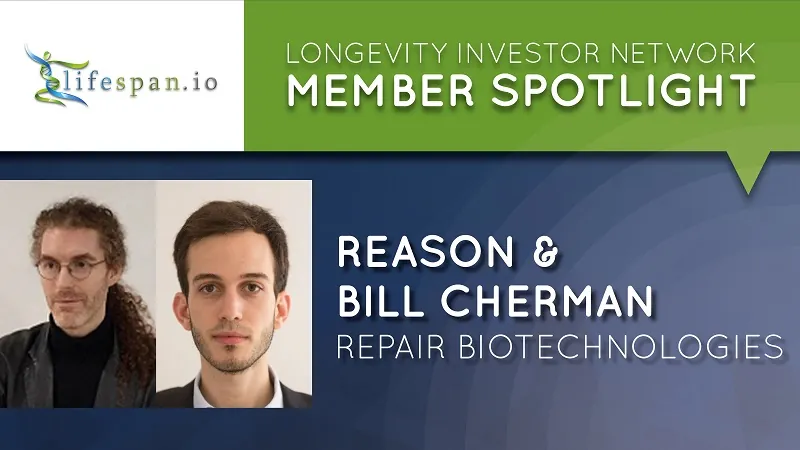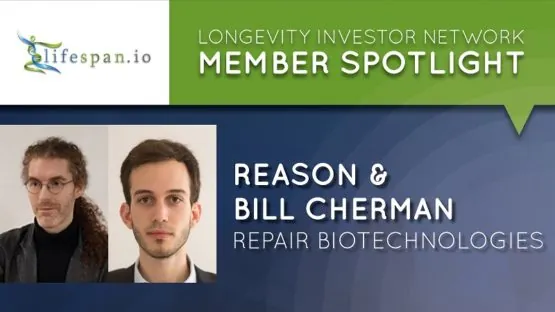Here at LEAF, we engage in a wide range of activities in support of the development of rejuvenation biotechnology in order to end age-related diseases. We report the latest news in aging research, attend conferences and give talks, educate, advocate, and fundraise for research projects on Lifespan.io; recently, we implemented the Longevity Investor Network in order to bring startup companies and investors together.
The Longevity Investor Network
The Longevity Investor Network is a group of investors who meet every month and invite young biotech companies working on aging to pitch their ideas. A successful pitch can often mean funding for a new startup company, helping to get its product developed and into clinical trials.
We had the opportunity to speak with two of the Longevity Investor Network members, Reason, and Bill Cherman, the co-founders of the new startup Repair Biotechnologies, Inc.
Reason is the CEO of Repair Biotechnologies, and many advocates also know him as the owner of Fight Aging!, a blog focused on rejuvenation biotechnology and aging research. Reason is also an active angel investor in the industry.
Bill is the Chairman of Repair Biotechnologies and a partner at Front Seat Capital, where he heads up investments in biotech and blockchain technology. Prior to this, he was a consultant at McKinsey & Company.
Why did you decide to join the Longevity Investor Network?
Reason: Connections are everything in angel investing. Since my agenda is as much to foster such connections in order to expand the pool of interested investors as it is to advance the state of rejuvenation research by investing, it makes perfect sense to participate in investor-led initiatives arising from our community. Many of the people involved in investing in rejuvenation research startups are still only dipping their toes in the water, and they see themselves somewhere in a process of learning and discovery. Talking to them can often help to accelerate that process, but to do that, one has to find out who they are and meet them first.
Bill: I noticed that the leading investors and startups in the space were a part of it. Networking with and learning from the most brilliant minds, in any industry, is key to successful investing, in my view.
Why, generally, do you invest in longevity companies?
Reason: It is an effective means of advancing the state of rejuvenation biotechnologies that are at a certain stage of maturity. It is at least ten times easier to raise investment funding than it is to raise philanthropic funding, but there is very little difference in the use such money is put to when comparing late-stage lab work with early-stage startup work. Venture capital and its angel community cousin like to present themselves as bold and risk-taking, but there is nonetheless an awful lot of herd behavior taking place. Investors follow for preference. A great deal can be accomplished in terms of steering money to sensible destinations by stepping out in front of the crowd and presenting a solid rationale for investment choices, by being the first to put some money down and explaining in detail why you choose to do that. It works at the level of small angel investments, and it works at the level of Jim Mellon’s Juvenescence venture.
Bill: There are mission and financial motivations. Mission-wise, no industry can have a more positive impact on humanity than the longevity industry; after all, life is man’s fundamental value, and all others require it.
Biotech startup investing has historically delivered distinctive results to investors; if longevity startups succeed in extending healthspan, even larger financial outcomes will follow, I believe. I particularly like early-stage preclinical companies, which are often valued in the 7-, low-8-digit range and can IPO and reach unicorn status in as early as 2-3 years.
Why do you think now is the right time for investors to get involved in the sector?
Reason: It has matured enough to the point at which follow-on funding is there for companies that succeed in their seed stage. It has not matured to the point at which every opportunity is chased by capital or even recognized as viable. Anyone with a high-level grasp of the science can easily identify dozens of opportunities to produce rejuvenation treatments just waiting for funding and entrepreneurs to step in and do good work.
Bill: The science gets stronger by the day, there are enough interesting projects and exceptional founders to fund, and there is still a huge valuation gap between seed-stage startups and buyout/IPO-ready companies, all of which investors can take advantage of today.
Not that I am complaining about a good thing, but I imagine early-stage valuations will rise significantly after the first FDA approval of a longevity drug (possibly a senolytic in 2025 or so). Even now, we already are seeing a rise in early-stage valuations as more Silicon Valley investors dive into the space (for example, Y Combinator with its anti-aging track).
Why do you see value in having a network of investors who share and collaborate on deals?
Reason: Rare is the deal in which a network of investors was not in some way involved in bringing it about. The present ad hoc assembly of happenstance meetings, persuasion, and passage of information is an essential part of setting up companies, even if the investment is ultimately made by just a few of those participants. Formalizing the networks helps greatly in lowering the barriers to entry for entrepreneurs (and there are never enough entrepreneurs) and to finding good investment opportunities on the part of investors. AngelList, I think, has proven this quite comprehensively. The same applies at any level of investment.
Ultimately, however, this is a little different from your run-of-the-mill investment where, at the end of the day ,the point is to obtain more of those funnily little tokens called money. Here, the goal is more life and the medical control of aging, and, at some point, the funny little tokens become a little less important than getting the job done. That dynamic is still shaking itself out, but I think we need communities whose members recognize that doing no more than aiming at increments of net worth to enable an ever-more luxurious tomb marker at some increasingly near point in the future is obsolete thinking when it comes to life science investment.
Bill: I would note there is value to investors and entrepreneurs. Investors get a more curated deal flow and a more thorough due diligence process, while entrepreneurs, many of whom lack business experience (to their benefit, many times), get access to several people who they can bounce ideas with and who can give them some guidance on fundraising, communicating with stakeholders, etc.
What is the most difficult part of investing in rejuvenation biotechnology companies?
Reason: That varies by investor. I think the biggest challenges are (a) that investors not already familiar with our community will struggle to know of the most important opportunities before they happen and (b) investors who have not internalized the SENS view of aging will invest in approaches that have a low probability of producing meaningful results in humans, as they do not address any of the fundamental causes of aging.
Bill: Finding entrepreneurs who will not give up in the face of the repeated failures and necessary pivots characteristic of biotech and the cumbersome regulatory process to get a drug approved.
What do you hope the Longevity Investor Network can grow into?
Reason: A much bigger group of investors who largely understand that the point of this exercise is to generate a world in which aging can be controlled and that funding and profit are just means to an end. In a world in which money can truly buy additional health in late life, buy time spent vigorously alive, then money is somewhat less important than it is today. The point becomes living, and, in this, we all win together or we all lose together. Senolytics show the way: high-tech development at the core, and a surrounding halo of cheap, highly beneficial treatments, something that will benefit the entire world as a result of early investments in the field.
Bill: Ideally, a one-stop shop for longevity startups to quickly raise money from smart and helpful investors, so they don’t have to burn months of energy with fundraising and can go back to the science as soon as possible.
Do you have any advice for investors looking to begin investing in longevity companies?
Reason: Talk to people. Join a network. Figure out what you think about the underlying science. If you don’t understand enough of the science of aging and rejuvenation to have an opinion on why one approach is better than another, then you are at the mercy of anyone who claims to have a worthwhile technical agenda. However, these technical agendas are not all the same, and some are much better than others, with a much greater expectation value when it comes to odds of success at every stage on the way through the development pipeline.
Bill: I would say general investing advice applies well to this space: read a lot (my partner Reason’s Fight Aging is a tremendous resource), talk to entrepreneurs, talk to fellow investors.
We would like to thank Reason and Bill for taking the time to do this interview with us. If you are interested in joining the Longevity Investor Network, get in touch with us.




